Macromolecule - Study guides, Class notes & Summaries
Looking for the best study guides, study notes and summaries about Macromolecule? On this page you'll find 2096 study documents about Macromolecule.
All 2.096 results
Sort by
 Popular
Popular
-
Portage Learning Chem 210 Biochem Final Exam 2023/2024 SOLVED
- Exam (elaborations) • 9 pages • 2024
- Available in package deal
-
 DoctorHkane
DoctorHkane
-
- $7.99
- 7x sold
- + learn more
T/F: According to the module, a compound with a molecular mass of 1,000 g/mol is considered a macromolecule. - ANSWER-false macromolecule >5,000 g/mol T/F: Biomolecules can have two or more different functional groups. - ANSWER-true T/F: The following group is an amine. C2H5NH2 - ANSWER-true T/F: In a eukaryotic cell, the organelles called peroxisomes serve the purpose of digesting macromolecules. - ANSWER-false peroxisomes degrade dangerous/hazardous molecules, lysosomes degrade mac...
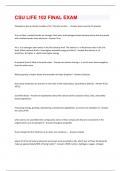 Popular
Popular
-
CSU LIFE 102 FINAL EXAM QUESTIONS & ANSWERS SOLVED 100% CORRECT!
- Exam (elaborations) • 17 pages • 2024 Popular
- Available in package deal
-
 PatrickKaylian
PatrickKaylian
-
- $7.99
- 1x sold
- + learn more
Phosphorus has an atomic number of 15. This tells us that... - Answer-there must be 15 protons True or False: covalent bonds are stronger than ionic and hydrogen bonds because atoms that are joined with covalent bonds share electrons - Answer-True An e- in a hydrogen atom exists in the first valence shell. The valence e- of Aluminum exist in the 3rd shell. Which valence shell e- have higher potential energy and why? - Answer-the valence e- of aluminum, bc higher e- shells have higher energy...

-
Organic Chemistry Module 8 Portage 219 TEST EXAM FINALS QUESTIONS WITH 100% VERIFIED SOLUTIONS
- Exam (elaborations) • 15 pages • 2023
- Available in package deal
-
 EWLindy
EWLindy
-
- $10.99
- 12x sold
- + learn more
Organic Chemistry Module 8 Portage 219 TEST EXAM FINALS QUESTIONS WITH 100% VERIFIED SOLUTIONS Polymer - ANSWER large molecule made by repetitive linking of smaller units (monomers) Macromolecule - ANSWER very large molecule composed of thousands of covalently bonded atoms (ex: polymer) 1. natural (in nature) 2. synthetic (in lab) - ANSWER two ways polymers are made rubber, carbs: starch & cellulose, proteins, nucleic acids DNA, RNA - ANSWER natural polymers nylon, teflon, sty...
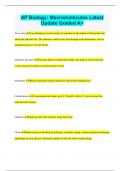
-
AP Biology: Macromolecules Latest Update Graded A+
- Exam (elaborations) • 8 pages • 2024
- Available in package deal
-
 StellarScores
StellarScores
-
- $9.99
- + learn more
AP Biology: Macromolecules Latest Update Graded A+ Active Site A pocket/groove on the surface of a protein on the surface of the protein into which the substrate fits. The substrate is held to this area through weak interactions, such as hydrogen bonds or Van der Waals. Allosteric Enzymes Enzymes that can change their shape: one shape is active (reaction occurs) and one is inactive (reaction doesn't occur) Antibodies Bind to particular foreign substances that fit their binding si...
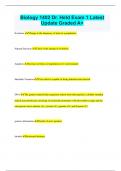
-
Biology 1402 Dr. Held Exam 1 Latest Update Graded A+
- Exam (elaborations) • 23 pages • 2024
- Available in package deal
-
 BrilliantScores
BrilliantScores
-
- $9.99
- 1x sold
- + learn more
Biology 1402 Dr. Held Exam 1 Latest Update Graded A+ Evolution Change in the frequency of traits in a population. Natural Selection Cause of the change in evolution. Adaption Increase in fitness of population to it's environment Heritable Variation Trait which is capable of being inherited and selected DNA The genetic material that organisms inherit from their parents; a double-stranded helical macromolecule consisting of nucleotide monomers with deoxyribose sugar and the ni...
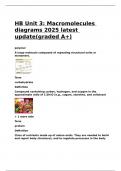
-
HB Unit 3 Macromolecules diagrams 2025 latest update(graded A+)
- Exam (elaborations) • 8 pages • 2024
-
 BRAINBOOSTERS
BRAINBOOSTERS
-
- $16.49
- + learn more
polymer A large molecule composed of repeating structural units or monomers. Term carbohydrate Definition Compound containing carbon, hydrogen, and oxygen in the approximate ratio of C:2H:O (e.g., sugars, starches, and cellulose) + 1 more side Term protein Definition Class of nutrients made up of amino acids. They are needed to build and repair body structures, and to regulate processes in the body + 1 more side Term lipid Definition Organic molecules made of carbo...
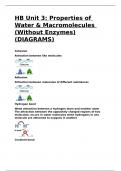
-
HB Unit 3 Properties of Water & Macromolecules (Without Enzymes)(DIAGRAMS)
- Exam (elaborations) • 12 pages • 2024
-
 BRAINBOOSTERS
BRAINBOOSTERS
-
- $14.49
- + learn more
Cohesion Attraction between like molecules Adhesion Attraction between molecules of different substances Hydrogen bond Weak attraction between a hydrogen atom and another atom The attraction between the oppositely charged regions of two molecules; occurs in water molecules when hydrogens in one molecule are attracted to oxygens in another Covalent bond A type of strong chemical bond in which two atoms share one or more pairs of valence electrons. A chemical bond between two ...
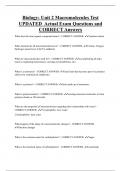
-
Biology: Unit 2 Macromolecules Test UPDATED Actual Exam Questions and CORRECT Answers
- Exam (elaborations) • 17 pages • 2024
- Available in package deal
-
 MGRADES
MGRADES
-
- $9.99
- + learn more
Biology: Unit 2 Macromolecules Test UPDATED Actual Exam Questions and CORRECT Answers What does the term organic compound mean? - CORRECT ANSWER- contains carbon What elements do all macromolecules have? - CORRECT ANSWER- Carbon, Oxygen, Hydrogen (some have N & P in addition) What are macromolecules used for? - CORRECT ANSWER- accomplishing all tasks (such as regulating homeostasis, carrying out metabolism, etc)
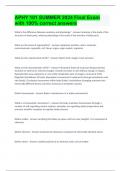
-
Anatomy and physiology 1APHY 101 SUMMER 2024 Final Exam with 100% correct answers
- Exam (elaborations) • 28 pages • 2024
- Available in package deal
-
 StarScoreGrades
StarScoreGrades
-
- $12.99
- 1x sold
- + learn more
APHY 101 SUMMER 2024 Final Exam with 100% correct answers What is the difference between anatomy and physiology? - Answer Anatomy is the study of the structure of body parts, whereas physiology is the study of the function of body parts What are the levels of organization? - Answer subatomic particles, atom, molecule, macromolecule, organelle, cell, tissue, organ, organ system, organism What are the requirements of life? - Answer Water, food, oxygen, heat, pressure What are the chara...

-
Bio Notes/Summary: All About Macromolecules
- Summary • 17 pages • 2024
-
 nmzamora72
nmzamora72
-
- $5.49
- 1x sold
- + learn more
These are college notes and summaries containing key words, definitions, examples, sample questions, images, and useful links to other sources that is vital to help comprehension about the topic of macromolecules. These notes will greatly aid you as you take general biology 1.
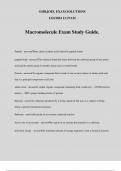
-
Macromolecule Exam Study Guide.
- Exam (elaborations) • 9 pages • 2024
-
 sirjoel
sirjoel
-
- $10.49
- + learn more
Macromolecule Exam Study Guide. Peptide - answerShort chain of amino acids linked by peptide bonds peptide bond - answerThe chemical bond that forms between the carboxyl group of one amino acid and the amino group of another amino acid, covalent bonds Protein - answerAn organic compound that is made of one or more chains of amino acids and that is a principal component of all cells amino acids - answera simple organic compound containing both a carboxyl (—COOH) and an amino (—NH2) gro...

Do you wonder why so many students wear nice clothes, have money to spare and enjoy tons of free time? Well, they sell on Stuvia! Imagine your study notes being downloaded a dozen times for $15 each. Every. Single. Day. Discover all about earning on Stuvia


